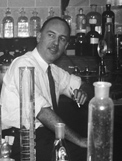DTP Branches and Offices
Milestone (1955)

Dr. Jonathan Hartwell in his laboratory. Courtesy of NCI. 1950.

NIH Building 6, the first home of the National Cancer Institute. Courtesy of NCI. 1955.
Creation of CCNSC
DTP’s goal is to turn “molecules into medicine for the public health” by facilitating the discovery and development of anticancer agents in collaboration with the intramural and the extramural research communities. Overall, DTP has had a role in the discovery or development of approximately 40 of the current U.S.-licensed chemotherapeutic agents, with the rest coming directly from the domestic or international pharmaceutical industry.2,3
The National Advisory Cancer Council convened in December 1952 to discuss problems related to the chemotherapy of cancer and respond to this question: Is the area of chemotherapy sufficiently promising scientifically at this time to warrant an attempt to obtain funds for its expansion? The Council concluded that the state of knowledge was inadequate to justify creating a program in cancer chemotherapeutic discovery.
But in 1955, Congress approved the creation of the Cancer Chemotherapy National Service Center (CCNSC) and provided $5 million, of which $4.2 million was earmarked for cancer research grants. Additionally, $800,000 was set aside for acquiring test compounds and evaluating them as possible anticancer therapeutic agents. Consequently, four screening centers were set up and operated through the CCNSC.1
The first review of the program occurred in the late 1950s, after the screening of approximately 11,000 compounds. The reviewers concluded, "The CCNSC is encouraging the development of new screening methods which will predict compounds useful against human tumors more accurately than do present-day methods." The CCNSC was operating at a time when there was no agreement on what models to use, how to use them, or even what changes in the tumor constituted activity. In fact, one of the early problems faced by CCNSC staff was the overly positive interpretation that suppliers of compounds attributed to the screening data, a problem that persists to this day.
In 1963, as a result of the second review of the program, the intramural laboratories in the clinical and experimental therapeutics area were integrated with the CCNSC to create more interdisciplinary teams. An NIH committee report on the activities of the CCNSC in 1965 recommended a third review of the program and a strengthening of the scientific staff. In 1976, the CCNSC was incorporated into NCI’s Developmental Therapeutics Program (DTP), the current locus of federally funded preclinical drug discovery and development.
DTP reorganized again subsequent to a 1995–1996 institutional review, which advised separating the intramural laboratories from the extramural program. A review committee report in 1998 recommended that DTP efforts de-emphasize the internal drug pipeline and focus on facilitating extramural discovery efforts. DTP is currently staffed by 73 full-time federal employees and has a budget approximately ten times the original appropriation.
1 Zubrod CG, Schepartz SA, Carter SK. Historical background of the National Cancer Institute’s drug development thrust. Natl Cancer Inst Monogr 1977;45:7–11.
2 Sausville EA, Johnson JI. Molecules for the millennium: how will they look? New drug discovery year 2000. Br J Cancer 2000;83:1401–1404.
3 Newhouse JP, Mendelsohn J, Gelband H, Herdman R. Federal Agency Roles in Cancer Drug Development from Preclinical Research to New Drug Approval: The National Cancer Institute and the Food and Drug Administration. Washington, DC: Institute of Medicine, 2005.





